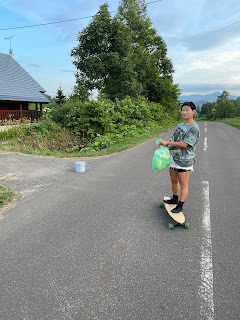For twenty-two days, little piles of dirty garbage have been propping up all over the house. They wait patiently unattended until the resident Trash Goblin crawls by to snatch them. The fastidious Goblin takes its stinky treasures to an unoccupied corner and dutifully sorts them into categories for proper disposal…
In the United States, you wail just about any kind of waste into a big green garbage bin and roll it out to the street once a week. Recycling goes out in the blue bin bimonthly (this stuff all ends up in the landfill anyways though, right🫥?). Got excess or stuff that won’t fit in your bins? Drive it to any one of those massive public dumpsters around town. Not much to it.
Moving into our house in Japan, we generated a lot of trash, very fast. Before we (as in I) could get a handle on the trash system here, we’d thrown everything into the same plastic bag. Containers, plastic and glass bottles, food scraps, cardboard, tissues, rags etc. all in one like the big green bin brained Americans we are. What wouldn’t be any cause for concern in the US was certainly an issue now.
Here’s why.
(~‾▿‾)~
An attempt at a brief breakdown of Japan’s garbage disposal system:
There are four main categories of garbage that get collected and disposed of separately here. Burnable (combustible) garbage, non-burnable (noncombustible) garbage, organic (food) waste, and recycling. Combustibles are incinerated and include waste like paper towels, paper, cloth, plastics, and rubber. Noncombustible can’t be incinerated and include metals, appliances, lightbulbs, and glass. Food waste is food waste and recycling encompasses roughly the same things as anywhere else in the world.
At first glance this isn’t bending anyone’s brain backwards.
Until you realise that PET plastic is different from PET 1 plastic is different from プラ(pura) plastic is different from burnable plastic and, oh, you thought paper was burnable? Nope. It needs to be recycled flat in even bundles not exceeding precise weight and size dimensions and tied crisscross. Same goes for cardboard boxes. Milk and juice cartons need the entire plastic cap mechanism removed (this goes in プラ FYI), cut open and laid flat, dried, bundled, and tied. If you think something is cardboard, chances are it’s 紙 (kami). Styrofoam can’t go in the blue bin back in the US but in Japan it’s recyclable. But keep packing styrofoam separate from styrofoam trays. For oversized items you’ll need to make some calls. Now, wanna know about steel and aluminum?
To seal this magical deal, each type of garbage goes in its own designated bag issued by the town you’re living in. We’re in Niseko but if we were to purchase and use bags from neighboring Kutchan ten minutes away our garbage would not be picked up. Most frighteningly, if you’ve incorrectly sorted your garbage, it also won’t be picked up.
Please, at least tell me that pickup is simple??
Sure. Combustible is every Thursday, noncombustible is the second and fourth Friday of every month, food waste is every Monday and Thursday, and recycling is every Wednesday. Trash needs to be dropped off in your designated shared garbage station before 8AM on pickup days.
When we arrived, nobody knew where our garbage station was. Not even the landlord knew where our garbage station was. He and his wife had to go walk around the neighborhood to find it. And if you think you can get away with tossing your trash in a different garbage station, think again because every garbage station has different pickup days. And if you miss a pickup day? Time to live in fear that your neighbors will know it was you who left a bag of raw chicken fat scraps in the station on a non-designated day.
[the elusive garbage station]
I’m planning to make a big unavoidable poster for my uncooperative housemates. I will let you know if that quells the burdens of the Goblin or if I end up taking the mess-makers out with the trash on food waste day.
[trash & me]










No comments:
Post a Comment